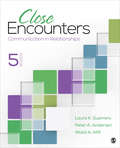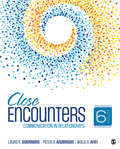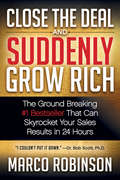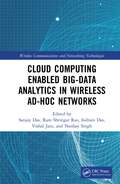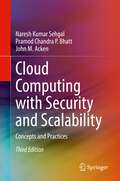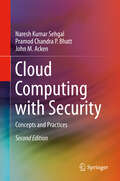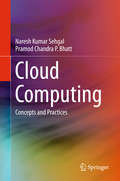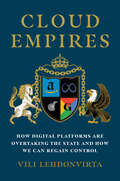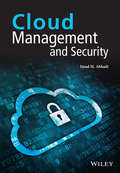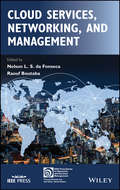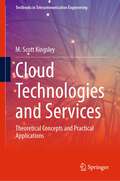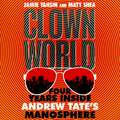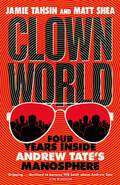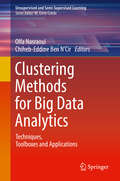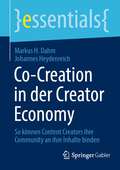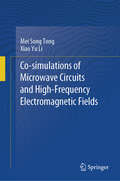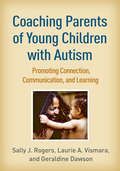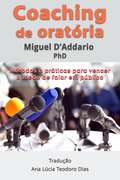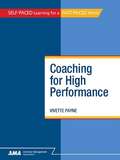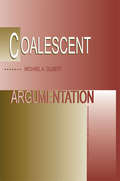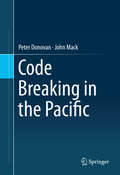- Table View
- List View
Close Encounters: Communicating in Relationships
by Walid A. Afifi Peter A. Andersen Laura K. GuerreroClose Encounters provides more in-depth coverage of theory than is typical in most interpersonal communication textbooks.
Close Encounters: Communication in Relationships
by Dr Laura K. Guerrero Dr Peter A. Andersen Dr Walid AfifiA relational approach to the study of interpersonal communication Close Encounters: Communication in Relationships, Fifth Edition helps students better understand their relationships with romantic partners, friends, and family members. Bestselling authors Laura K. Guerrero, Peter A. Andersen, and Walid A. Afifi offer research-based insights and content illustrated with engaging scenarios to show how state-of-the-art research and theory can be applied to specific issues within relationships—with a focus on issues that are central to describing and understanding close relationships. While maintaining the spotlight on communication, the authors also emphasize the interdisciplinary nature of the study of personal relationships by including research from such disciplines as social psychology and family studies. The book covers issues relevant to developing, maintaining, repairing, and ending relationships. Both the "bright" and "dark" sides of interpersonal communication within relationships are explored.
Close Encounters: Communication in Relationships
by Dr Laura K. Guerrero Dr Peter A. Andersen Dr Walid AfifiA relational approach to the study of interpersonal communication Close Encounters: Communication in Relationships, Fifth Edition helps students better understand their relationships with romantic partners, friends, and family members. Bestselling authors Laura K. Guerrero, Peter A. Andersen, and Walid A. Afifi offer research-based insights and content illustrated with engaging scenarios to show how state-of-the-art research and theory can be applied to specific issues within relationships—with a focus on issues that are central to describing and understanding close relationships. While maintaining the spotlight on communication, the authors also emphasize the interdisciplinary nature of the study of personal relationships by including research from such disciplines as social psychology and family studies. The book covers issues relevant to developing, maintaining, repairing, and ending relationships. Both the "bright" and "dark" sides of interpersonal communication within relationships are explored.
Close Encounters: Communication in Relationships
by Peter A. Andersen Laura K. Guerrero Walid AfifiClose Encounters: Communication in Relationships helps students learn about their own relationships with romantic partners, friends, and family members by focusing on issues that are central to describing and understanding close relationships. Best-selling authors Laura K. Guerrero, Peter A. Andersen, and Walid A. Afifi present research-based insights and content illustrated with engaging scenarios to show how state-of-the-art research and theory can be applied to specific issues within relationships. The updated Sixth Edition includes fresh content reflecting current research and trends in relationships, balanced with coverage of classic research, and continues to empower readers to be more critical consumers of information about relationships.
Close Encounters: Communication in Relationships
by Peter A. Andersen Laura K. Guerrero Walid AfifiClose Encounters: Communication in Relationships helps students learn about their own relationships with romantic partners, friends, and family members by focusing on issues that are central to describing and understanding close relationships. Best-selling authors Laura K. Guerrero, Peter A. Andersen, and Walid A. Afifi present research-based insights and content illustrated with engaging scenarios to show how state-of-the-art research and theory can be applied to specific issues within relationships. The updated Sixth Edition includes fresh content reflecting current research and trends in relationships, balanced with coverage of classic research, and continues to empower readers to be more critical consumers of information about relationships.
Close the Deal & Suddenly Grow Rich: The Ground Breaking #1 Bestseller that can Skyrocket Your Sales Results in 24 Hours
by Marco RobinsonClose the Deal & Suddenly Grow Rich is the ONLY sales book that reveals exactly WHEN to close the deal using the power of a B.R.A.N.D to transform sales results within 24 hours. Being homeless many times as a child after Marco Robinson&’s mum left his father when he was just two years old because of immense debt, he knows what it&’s like to sleep on park benches, be bullied from school to school, etc. Close the Dea & Suddenly Grow Richl is a true rags-to-riches story of someone who was willing to fight, never gave up, and became the best he could be at sales. At the heart of Marco&’s passion is giving back after his own difficult childhood. In a universal and conversational style, Marco shares his B.R.A.N.D. new concept of 21st century sales and communication technology that transforms sales results within 24 hours and catapults any working professional to the top levels of seven-figure earners at light speed!
Cloud Computing Enabled Big-Data Analytics in Wireless Ad-hoc Networks (Wireless Communications and Networking Technologies)
by Sanjoy DasThis book discusses intelligent computing through Internet of Things (IoT) and Big Data in vehicular environments in a single volume. It covers important topics, such as topology-based routing protocols, heterogeneous wireless networks, security risks, software-defined vehicular ad-hoc networks, vehicular delay tolerant networks, and energy harvesting for WSNs using rectenna. Features Covers applications of IoT in Vehicular Ad-hoc Network (VANETs) Discusses use of machine learning and other computing techniques for enhancing performance of networks Explains game theory-based vertical handoffs in heterogeneous wireless networks Examines monitoring and surveillance of vehicles through the vehicular sensor network Investigates theoretical approaches on software-defined VANET The book is aimed at graduate students and academic researchers in the fields of electrical engineering, electronics and communication engineering, computer science, and engineering.
Cloud Computing with Security and Scalability.: Concepts and Practices
by Naresh Kumar Sehgal Pramod Chandra Bhatt John M. AckenThis book provides readers with an overview of Cloud Computing, starting with historical background on mainframe computers and early networking protocols, leading to current concerns such as hardware and systems security, performance, emerging areas of IoT, Edge Computing, and healthcare etc. Readers will benefit from the in-depth discussion of cloud computing usage and the underlying architectures. The authors explain carefully the “why’s and how’s” of Cloud Computing, so engineers will find this book an invaluable source of information to the topic. This third edition includes new material on Cloud Computing Scalability, as well as best practices for using dynamic cloud infrastructure, and cloud operations management with cost optimizations. Several new examples and analysis of cloud security have been added, including ARM architecture and https protocol.Provides practical guidance for software developers engaged in migrating in-house applications to Public Cloud;Describes for IT managers how to improve their Cloud Computing infrastructures;Includes coverage of security concerns with Cloud operating models;Uses several case studies to illustrate the “why’s and how’s” of using the Cloud;Examples and options to improve Cloud Computing Scalability.
Cloud Computing with Security: Concepts and Practices
by Naresh Kumar Sehgal Pramod Chandra Bhatt John M. AckenThis book provides readers with an overview of Cloud Computing, starting with historical background on mainframe computers and early networking protocols, leading to current concerns such as hardware and systems security, performance, emerging areas of IoT, Edge Computing etc. Readers will benefit from the in-depth discussion of cloud computing usage and the underlying architectures. The authors explain carefully the “why’s and how’s” of Cloud Computing, so engineers will find this book an invaluable source of information to the topic. This second edition includes new material on Cloud Computing Security, Threat Vectors and Trust Models, as well as best practices for a using dynamic cloud infrastructure, and cloud operations management. Several new examples and analysis of cloud security have been added, including edge computing with IoT devices.
Cloud Computing: Concepts And Practices
by Naresh Kumar Sehgal Pramod Chandra P. BhattThis book provides readers with an overview of Cloud Computing, starting with historical background on mainframe computers and early networking protocols, leading to current concerns such as hardware and systems security, performance, emerging areas of IoT, Edge Computing etc. Readers will benefit from the in-depth discussion of cloud computing usage and the underlying architecture, with focus on best practices for using a dynamic cloud infrastructure, cloud operations management and cloud security. The authors explain carefully the “why’s and how’s” of Cloud Computing, so engineers will find this book and invaluable introduction to the topic.
Cloud Empires: How Digital Platforms Are Overtaking the State and How We Can Regain Control
by Vili LehdonvirtaThe rise of the platform economy into statelike dominance over the lives of entrepreneurs, users, and workers.The early Internet was a lawless place, populated by scam artists who made buying or selling anything online risky business. Then Amazon, eBay, Upwork, and Apple established secure digital platforms for selling physical goods, crowdsourcing labor, and downloading apps. These tech giants have gone on to rule the Internet like autocrats. How did this happen? How did users and workers become the hapless subjects of online economic empires? The Internet was supposed to liberate us from powerful institutions. In Cloud Empires, digital economy expert Vili Lehdonvirta explores the rise of the platform economy into statelike dominance over our lives and proposes a new way forward. Digital platforms create new marketplaces and prosperity on the Internet, Lehdonvirta explains, but they are ruled by Silicon Valley despots with little or no accountability. Neither workers nor users can &“vote with their feet&” and find another platform because in most cases there isn&’t one. And yet using antitrust law and decentralization to rein in the big tech companies has proven difficult. Lehdonvirta tells the stories of pioneers who helped create—or resist—the new social order established by digital platform companies. The protagonists include the usual suspects—Amazon founder Jeff Bezos, Travis Kalanick of Uber, and Bitcoin&’s inventor Satoshi Nakamoto—as well as Kristy Milland, labor organizer of Amazon&’s Mechanical Turk, and GoFundMe, a crowdfunding platform that has emerged as an ersatz stand-in for the welfare state. Only if we understand digital platforms for what they are—institutions as powerful as the state—can we begin the work of democratizing them.
Cloud Management and Security
by Imad M. AbbadiWritten by an expert with over 15 years’ experience in the field, this book establishes the foundations of Cloud computing, building an in-depth and diverse understanding of the technologies behind Cloud computing. In this book, the author begins with an introduction to Cloud computing, presenting fundamental concepts such as analyzing Cloud definitions, Cloud evolution, Cloud services, Cloud deployment types and highlighting the main challenges. Following on from the introduction, the book is divided into three parts: Cloud management, Cloud security, and practical examples. Part one presents the main components constituting the Cloud and federated Cloud infrastructure (e.g., interactions and deployment), discusses management platforms (resources and services), identifies and analyzes the main properties of the Cloud infrastructure, and presents Cloud automated management services: virtual and application resource management services. Part two analyzes the problem of establishing trustworthy Cloud, discusses foundation frameworks for addressing this problem – focusing on mechanisms for treating the security challenges, discusses foundation frameworks and mechanisms for remote attestation in Cloud and establishing Cloud trust anchors, and lastly provides a framework for establishing a trustworthy provenance system and describes its importance in addressing major security challenges such as forensic investigation, mitigating insider threats and operation management assurance. Finally, part three, based on practical examples, presents real-life commercial and open source examples of some of the concepts discussed, and includes a real-life case study to reinforce learning – especially focusing on Cloud security. Key Features • Covers in detail two main aspects of Cloud computing: Cloud management and Cloud security • Presents a high-level view (i.e., architecture framework) for Clouds and federated Clouds which is useful for professionals, decision makers, and students • Includes illustrations and real-life deployment scenarios to bridge the gap between theory and practice • Extracts, defines, and analyzes the desired properties and management services of Cloud computing and its associated challenges and disadvantages • Analyzes the risks associated with Cloud services and deployment types and what could be done to address the risk for establishing trustworthy Cloud computing • Provides a research roadmap to establish next-generation trustworthy Cloud computing • Includes exercises and solutions to problems as well as PowerPoint slides for instructors
Cloud Services, Networking, and Management
by Nelson L. da Fonseca Raouf BoutabaCloud Services, Networking and Management provides a comprehensive overview of the cloud infrastructure and services, as well as their underlying management mechanisms, including data center virtualization and networking, cloud security and reliability, big data analytics, scientific and commercial applications. Special features of the book include: State-of-the-art content Self-contained chapters for readers with specific interests Includes commercial applications on Cloud (video services and games)
Cloud Technologies and Services: Theoretical Concepts and Practical Applications (Textbooks in Telecommunication Engineering)
by M. Scott KingsleyThis textbook provides a thorough yet compact review of cloud technologies. It offers easy to understand explanations of the technical concepts underlying cloud services, platforms, and applications offered by Amazon Web Services (AWS), Microsoft Azure, and the Google Cloud Platform (GCP). It presents cloud concepts at a depth that can be understood and applied by both technical and non-technical readers. Once that is accomplished the learner can then easily move toward more advanced topics. Or, they can use the knowledge gained from this book to obtain industry certifications and be competitive in this exciting industry. Reader learning is enhanced with quizzes and exam questions and hands-on labs throughout the book with PowerPoint slides, instructor guide and additional labs online. All the tools needed for advancement to the level of cloud architect are found in this book. The author has verified the success of this approach in his own academic environment with much success. He teaches Cloud Engineering and Advanced Cloud Engineering at Southern Methodist University. Both courses were developed in partnership with the AWS Academy, the education arm of the Amazon Web Services cloud platform. Using this methodology his students routinely take and pass cloud certification exams and obtain lucrative employment positions in the rapidly expanding cloud industry.
Clown World: Four Years Inside Andrew Tate's Manosphere
by Jamie Tahsin Matt Shea'This gripping book is destined to become THE book about Andrew Tate' Jon Ronson'A fascinating and disturbing investigation' Ian HislopThe behind-the-scenes story of a four-year investigation into Andrew Tate, exploring how a failed reality TV star turned accused organised criminal managed to become one of the most famous influencers in the world.In 2022, Andrew Tate went from a little-known kickboxer and failed reality TV star to a lifestyle icon for legions of men and boys, and a figure that would define a new era of misogyny. Tate started the year as a fringe internet celebrity, but by August he was the most googled man in the world. In that same month, Matt Shea and Jamie Tahsin gained access to his Bucharest compound and infamous War Room, making a documentary that would result in the first women coming forward to accuse him publicly of sexual and physical violence. Tate would end the year in a Romanian jail, facing charges of human trafficking, rape and being part of an organised crime group. But the investigations wouldn't stop there.Part Gonzo journalism, part masculinity rabbit hole, this book takes you on Shea and Tahsin's journey to reveal the dark secrets of Andrew Tate, the machine that brought him here, and the ideology he has unleashed on a generation of young men.'A sobering, strange and eye-opening look into the toxic manosphere. It should be required reading for anybody worried about the rise of incel culture and Andrew Tate' Zing Tsjeng'Rarely have I read anything so politically important that's also so gripping' Zoe Williams
Clown World: Four Years Inside Andrew Tate's Manosphere
by Jamie Tahsin Matt Shea'This gripping book is destined to become THE book about Andrew Tate' Jon Ronson'A fascinating and disturbing investigation' Ian HislopThe behind-the-scenes story of a four-year investigation into Andrew Tate, exploring how a failed reality TV star turned accused organised criminal managed to become one of the most famous influencers in the world.In 2022, Andrew Tate went from a little-known kickboxer and failed reality TV star to a lifestyle icon for legions of men and boys, and a figure that would define a new era of misogyny. Tate started the year as a fringe internet celebrity, but by August he was the most googled man in the world. In that same month, Matt Shea and Jamie Tahsin gained access to his Bucharest compound and infamous War Room, making a documentary that would result in the first women coming forward to accuse him publicly of sexual and physical violence. Tate would end the year in a Romanian jail, facing charges of human trafficking, rape and being part of an organised crime group. But the investigations wouldn't stop there.Part Gonzo journalism, part masculinity rabbit hole, this book takes you on Shea and Tahsin's journey to reveal the dark secrets of Andrew Tate, the machine that brought him here, and the ideology he has unleashed on a generation of young men.'A sobering, strange and eye-opening look into the toxic manosphere. It should be required reading for anybody worried about the rise of incel culture and Andrew Tate' Zing Tsjeng'Rarely have I read anything so politically important that's also so gripping' Zoe Williams
Clown World: Four Years Inside Andrew Tate's Manosphere
by Jamie Tahsin Matt Shea'This gripping book is destined to become THE book about Andrew Tate' Jon Ronson'A fascinating and disturbing investigation' Ian HislopThe behind-the-scenes story of a four-year investigation into Andrew Tate, exploring how a failed reality TV star turned accused organised criminal managed to become one of the most famous influencers in the world.In 2022, Andrew Tate went from a little-known kickboxer and failed reality TV star to a lifestyle icon for legions of men and boys, and a figure that would define a new era of misogyny. Tate started the year as a fringe internet celebrity, but by August he was the most googled man in the world. In that same month, Matt Shea and Jamie Tahsin gained access to his Bucharest compound and infamous War Room, making a documentary that would result in the first women coming forward to accuse him publicly of sexual and physical violence. Tate would end the year in a Romanian jail, facing charges of human trafficking, rape and being part of an organised crime group. But the investigations wouldn't stop there.Part Gonzo journalism, part masculinity rabbit hole, this book takes you on Shea and Tahsin's journey to reveal the dark secrets of Andrew Tate, the machine that brought him here, and the ideology he has unleashed on a generation of young men.'A sobering, strange and eye-opening look into the toxic manosphere. It should be required reading for anybody worried about the rise of incel culture and Andrew Tate' Zing Tsjeng'Rarely have I read anything so politically important that's also so gripping' Zoe Williams
Clustering Methods for Big Data Analytics: Techniques, Toolboxes and Applications (Unsupervised and Semi-Supervised Learning)
by Olfa Nasraoui Chiheb-Eddine Ben N'CirThis book highlights the state of the art and recent advances in Big Data clustering methods and their innovative applications in contemporary AI-driven systems. The book chapters discuss Deep Learning for Clustering, Blockchain data clustering, Cybersecurity applications such as insider threat detection, scalable distributed clustering methods for massive volumes of data; clustering Big Data Streams such as streams generated by the confluence of Internet of Things, digital and mobile health, human-robot interaction, and social networks; Spark-based Big Data clustering using Particle Swarm Optimization; and Tensor-based clustering for Web graphs, sensor streams, and social networks. The chapters in the book include a balanced coverage of big data clustering theory, methods, tools, frameworks, applications, representation, visualization, and clustering validation.
Co-Creation in der Creator Economy: So können Content Creators ihre Community an ihre Inhalte binden (essentials)
by Markus H. Dahm Johannes HeydenreichDieses essential wirft einen Blick auf die zunehmende Bedeutung von gemeinschaftlicher Kreation in der aufstrebenden Creator Economy und gibt Content-Erstellern wertvolle Einblicke und konkrete Ratschläge, wie sie durch die Zusammenarbeit mit Fans und Followern nicht nur die Arbeitslast teilen, sondern auch eine unterstützende Gemeinschaft aufbauen können. Das Buch analysiert erfolgreiche Co-Creation-Modelle, bei denen Content-Verfasser Inhalte gemeinsam entwickeln und dabei von gemeinsamen Vermarktungsstrategien und Monetarisierungsansätzen profitieren.
Co-simulations of Microwave Circuits and High-Frequency Electromagnetic Fields
by Mei Song Tong Xiao Yu LiThis book aims to provide many advanced application topics for microwave circuits and high-frequency electromagnetic (EM) fields by using advanced design system (ADS) and high-frequency structure simulator (HFSS) as simulation platforms. In particular, it contains the latest multidisciplinary co-simulation guidance on the design of relevant components and devices. Currently, the circuit/field design and performance analysis and optimization strongly rely on various kinds of robust electronic design automation (EDA) software. RF/microwave engineers must grasp two or more types of related simulation design software. ADS by Keysight and HFSS by Ansys are the representative for circuit simulations and for field and structural simulations of microwave devices, respectively. At present, these two types of software are widely used in enterprises, universities, and research institutions. The main purpose of this book is to enable readers, who are interested in microwave engineering and applied electromagnetics, to master the applications of these two tools. It also helps readers expand their knowledge boundaries behind those types of software and deepen their understanding of developing interdisciplinary technologies by co-simulations. The book is divided into three parts. The first part introduces the two latest versions of ADS and HFSS and helps readers better understand the basic principles and latest functions better. It also advises how to choose appropriate simulation tools for different problems. The second part mainly describes co-simulations for high-frequency EM fields, microwave circuits, antenna designs, EM compatibility (EMC), and thermal and structural analyses. It provides guides and advices on performing co-simulations by ADS and HFSS incorporated with other types of software, respectively. The last part narrates the automation interfaces and script programming methods for co-simulations. It primarily deals with the Advanced Extension Language (AEL), Python Data Link (PDL), and MATLAB interface in ADS. For HFSS, it discusses VBScript, IronPython scripting, and Application Programming Interface (APIs) based on MATLAB. Each topic contains practical examples to help readers understand so that they can gain a solid knowledge and skills regarding automated interfaces and scripting methods based on these kinds of software. Concisely written in combination with practical examples, this book is very suitable as a textbook in introductory courses on microwave circuit and EM simulations and also as a supplementary textbook in many courses on electronics, microwave engineering, communication engineering, and related fields. As well, it can serve as a reference book for microwave engineers and researchers.
Coaching Parents of Young Children with Autism: Promoting Connection, Communication, and Learning
by Geraldine Dawson Sally J. Rogers Laurie A. VismaraA growing body of evidence supports the benefits of high-quality parent interventions for building social and communication skills in 0- to 5-year-olds with autism spectrum disorder (ASD). How can clinicians coach parents to effectively incorporate learning opportunities into daily routines at home? From preeminent experts, this practical book explores the role of the coach and reviews the "whats," "whys," and "how-tos" of successful collaboration with parents. Topics include structuring coaching sessions, identifying children's needs, facilitating playful engagement, and deepening parents' understanding of how they can boost skills development during everyday activities. Seventeen reproducible handouts and forms include the multipage P-ESDM Infant–Toddler Curriculum Checklist, ideal for use in telehealth assessments. Purchasers get access to a webpage where they can download and print the reproducible materials in a convenient 8 1/2" x 11" size.
Coaching de oratória
by Miguel D'AddarioUm livro ideal para quem procura uma transformação face aos seus medos, aplicando o Coaching em práticas de oratória, conseguindo o impulso individual, a superação do objetivo, e sentindo-se incentivado a confrontar de cada vez que tem de se dirigir a um auditório; tanto para os profissionais, como para estudantes, advogados, docentes, funcionários, académicos, ou simplesmente para quem pretende aprender a desenvolver-se sem medos face a um público determinado.
Coaching for High Performance
by Vivette PayneCoach employees to ensure maximum performance, motivation and retention. Following a seven-step coaching process, Coaching for High Performance gives managers the tools to help their people excel at their jobs and meet competitive challenges with confidence. This book teaches managers how to communicate performance expectations, assess employee skill levels, establish the purpose of coaching, and agree on a coaching contract. Managers will learn the critical skills needed to conduct coaching conversations, adapt one’s coaching style to fit changing situations, and create a coaching plan. Readers will learn how to: • Establish the mission and role as a coach • Deliver feedback in any situation • Use coaching skills to motivate and retain employees • Coach employees across generations and throughout the employment life cycle • Enhance team performance and channel conflict constructively • Handle difficult coaching situations with insight and skill
Coalescent Argumentation
by Michael A. GilbertCoalescent Argumentation is based on the concept that arguments can function from agreement, rather than disagreement. To prove this idea, Gilbert first discusses how several components--emotional, visceral (physical) and kisceral (intuitive) are utilized in an argumentative setting by people everyday. These components, also characterized as "modes," are vital to argumentative communication because they affect both the argument and the resulting outcome. In addition to the components/modes, this book also stresses the goals in argumentation as a means for understanding one's own and one's opposer's positions. Gilbert argues that by viewing positions as complex human events involving a variety of communicative modes, we are better able to find commonalities across positions, and, therefore, move from conflict to resolution. By focusing on agreement and shared goals in all modes, arguers can coalesce diverse positions and more easily distinguish between minor or unrelated differences and core disagreements. This permits much greater latitude for locating shared beliefs, values, and attitudes that will lead to conflict resolution.
Code Breaking in the Pacific
by Peter Donovan John MackThis book reveals the historical context and the evolution of the technically complex Allied Signals Intelligence (Sigint) activity against Japan from 1920 to 1945. It traces the all-important genesis and development of the cryptanalytic techniques used to break the main Japanese Navy code (JN-25) and the Japanese Army's Water Transport Code during WWII. This is the first book to describe, explain and analyze the code breaking techniques developed and used to provide this intelligence, thus closing the sole remaining gap in the published accounts of the Pacific War. The authors also explore the organization of cryptographic teams and issues of security, censorship, and leaks. Correcting gaps in previous research, this book illustrates how Sigint remained crucial to Allied planning throughout the war. It helped direct the advance to the Philippines from New Guinea, the sea battles and the submarine onslaught on merchant shipping. Written by well-known authorities on the history of cryptography and mathematics, Code Breaking in the Pacific is designed for cryptologists, mathematicians and researchers working in communications security. Advanced-level students interested in cryptology, the history of the Pacific War, mathematics or the history of computing will also find this book a valuable resource.

